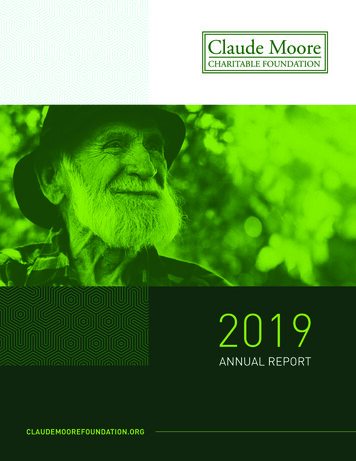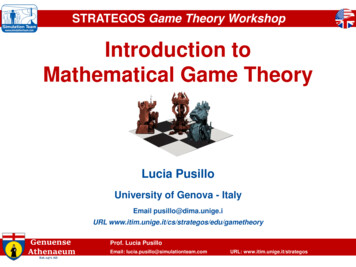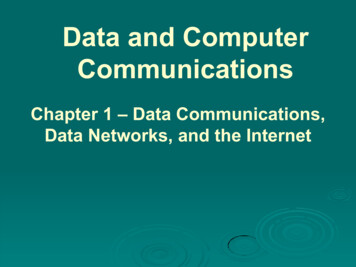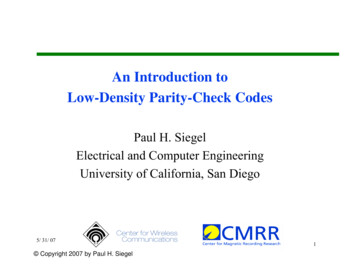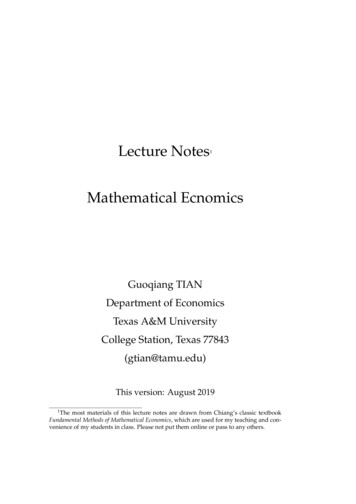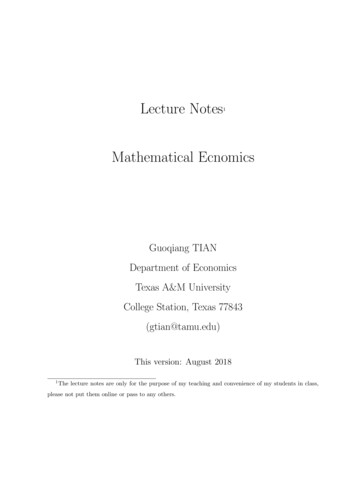
Transcription
Mathematical TheoryofClaude ShannonA study of the style and context of his workup to the genesis of information theory.byEugene Chiu, Jocelyn Lin, Brok Mcferron,Noshirwan Petigara, Satwiksai Seshasai6.933J / STS.420J The Structure of Engineering Revolutions
Table of y .7Information Theory.8Information Theory before Shannon.8What was Missing.151948 Mathematical theory of communication .16The Shannon Methodology .19Shannon as the architect.19Switching Theory .22Background and Contemporary Work.22Building Blocks to Shannon's Master's Thesis.23A Symbolic Analysis of Relay and Switching Circuits .26Theorems.28Negation Theorems .28Analogue Between the Calculus of Propositions and the Symbolic Relay Analysis.29An Example of a Synthesis Problem.29Popular Recognition .31Genetics.34An Algebra for Theoretical Genetics, the beginnings .34History of population genetics .35Eugenics .35Genetics in late 1930’s.37Genetics in early 1940’s .38Vannevar Bush, Claude Shannon, and genetics.38Shannon’s Ph.D.40Algebraic details.41Analysis and Comparison.43A Dead End .43Cryptography .47Relation to Information Theory.47Vernam System.50Link to Information Theory .52Shannon's Style.54Collaboration.54Advising .56The "great gadgeteer" .57Application of his work.60Awards and Recognition .61Conclusion .63References .65Correspondences .65Interviews .65Publications .662
AcknowledgementsWe would like to thank professors Robert Fano, Bob Gallagher, Chris Kaiser, Charles Vest andHartley Rogers for their academic and personal insight into Claude Shannon’s work and the fields ofswitching theory, genetics and information theory. Shannon’s advisees Trenchard More, WilliamSutherland and Henry Ernst provided us with a unique perspective on working with Dr. Shannon.Betty Shannon graciously discussed her husband’s personality and work. MIT staff Be Blackburnand Laura Mersky helped facilitate our research. The staff of the MIT Archives and Library ofCongress were instrumental in locating important documents and correspondences betweenShannon and his colleagues. Professor David Mindell and Teaching Assistant Chen-Pang Yeangwent beyond their roles as instructors and provided us with insight into their own research on thistopic.Finally, we would also like to thank Peter Elias, who before passing away on Dec. 7, 2001 allowed usto search through his extensive archive of books and documents related to Claude Shannon and hisfields. This paper is dedicated to his memory and the memory of Claude Shannon, who passed awayon February 24, 2001.3
IntroductionWhen Trenchard More first met Claude Elwood Shannon, he was taking his oral exam for his Ph. Dat the Massachusetts Institute of Technology1. The written exam was especially difficult at the time,recalled More, so doing well on the oral portion of the exam was vital. Shannon had agreed to be onMore's committee because More was a TA under Sam Caldwell, an advisor for Shannon's ownMaster's thesis.The questions Shannon asked were drastically different from the rest andconcentrated on the mathematical ideas behind the topics being discussed. Shannon was “after theways of thought,” said More. He cared more about how More was thinking and whether heunderstood the fundamental mathematical concepts behind his research. Shannon felt that someonewho really understood ideas could recreate them before your eyes, related More. Fortunately,despite having stumbled through the technical details in the written and oral exam, More haddeveloped a solid understanding of the mathematical concepts and passed the oral exams bysuccessfully answering Shannon's questions. He remembered another student meeting a differentfate with Shannon - despite his perfect GPA, the student could not answer Shannon's questions, andit was revealed that he was simply memorizing concepts. The focus Shannon displayed in hisquestioning of More was representative of the guiding vision which drove much of his work.The most popular and revolutionary pieces of Shannon's work came very early in his life. Manyexperts including MIT professor and colleague Robert Fano suggested that his two most importantscientific contributions were his Master's thesis and his revolutionary 1948 paper on communicationtheory2. His Master's thesis, developing a method for using Boolean logic to represent circuits, andhis 1948 paper on communication theory each helped to define a field and revolutionized the way in12Interview with Trenchard More, 2001.Interview with Robert Fano, 2001.4
which we viewed our world. At the heart of these two feats and much of his other work was theidea that mathematical concepts could be used to bring structure and understanding to almostanything.This paper is an attempt to understand the context of Shannon's early work and examine theelements that contributed to his research and the subsequent explosion of study in his fields. Ourgoal is to not only understand the research, but also the man who gave birth to it. By exploring thecommon threads between the many diverse areas of Shannon's research, the fundamental ideas thatdrove Shannon become evident.Much of the existing research on Shannon focuses on the work that had the greatest impact on thescientific community. As the creator of the field of information theory, he has been widely hailed asthe “father of the digital age.”3 His 1948 paper detailed a method for representing information andforever revolutionized the way in which information was conceptualized. This paper begins byattempting to understand the context in which Shannon produced this work on information theoryin the late 1940s.After understanding Shannon's role in this field, we return to the earlier work and examine a few ofhis major accomplishments before his landmark paper. Although his style was very independent andhis results were very unique, the areas in which he worked were very heavily influenced by externalfactors. Each of the areas of Shannon's work we consider - switching, genetics, information theoryand cryptography - were motivated by the environment which Shannon was in at the time, and thespecific interests of those advising him. He rarely displayed a sincere interest in promoting the3Waldrop, 2001.5
application and understanding of his work. Instead, he relied on the external factors to drive theinfusion of his work into the appropriate field.This paper pays careful attention to Shannon's Ph.D. thesis in genetics, which provides aninteresting example of the role of external influence in Shannon's work. The genetics thesis did notreceive nearly as much attention as his other work, but his contributions in the thesis are similar inscope and style to his work in switching theory and information theory. Again, the domain wasprovided by his environment, but his role was quite independent and dealt with using mathematicaltheory to represent the system.As with his other work, Shannon did little to promote thewidespread awareness or acceptance of his results. However, unlike his work in switching andinformation, his genetics work was not embraced by the community, and thus did not have as greatan impact as the other pieces.Examining Shannon's work style and interests further confirmed this notion of an individualfocused solely on the abstraction of a problem to its simplest form in any given field. As a studentand colleague, Shannon was described as very shy and independent, yet incredibly bright. As hemoved on to practice research professionally, both in industry and academia, his wife, advisees andcolleagues all described a man who avoided collaboration, focused on the mathematical theory, andmoved from subject to subject once being satisfied with having conquered the theoreticalunderpinnings of his topic of study. The professor who helped Trenchard More pass his Ph.D.exams by emphasizing the underlying mathematical theory employed this devotion in almost everyaspect of his life.6
The essence of Shannon's contributions was his style of work - his ability to take a problem andapply mathematical theory to revolutionize the way in which the field was viewed. The impact of hiswork was brought about by societal influences. The following pages will expose this reality anddemonstrate the power such a style has to change the world.MethodologyOur journey into the work of Shannon began just there - with an exploration of his major works inswitching, genetics, information theory and cryptography. After examining his work specifically, wecollected other primary source material of the time to get a sense of the context in which he wasworking.We examined works that Shannon cited, other related works of the time, andcorrespondences related to Shannon. Textbooks and commencement exercises of the time wereconsulted to obtain a sense of the state of his fields. Secondary historical sources provided abroader framework for our research, and provided many links between the various pieces westudied. Our choices in secondary source material were also driven by the fields of study weexplored, rather than studies of Claude Shannon himself. But to return the focus back to Shannon,it was vital to speak to those who had known him and worked with him. His wife, advisees,colleagues and friends provided invaluable insight into the style and interests of Shannon, andhelped us understand many of the unique characteristics of his life.7
Information TheoryInformation Theory before ShannonTo understand the contributions, motivations and methodology of Claude Shannon, it is importantto examine the state of communication engineering before the advent of Shannon’s 1948 paper, “AMathematical Theory of Communication”.Before 1948, communication was strictly an engineering discipline, with little scientific theory toback it up. In fact, one might even go as far as to liken communication engineering of the time to ablack art rather than the hard science it is today. Still, by the 1940’s there were a large number ofcommunication systems that were in use. Verdu, in his paper, “50 Years of Shannon Theory", listssome of the major ones as: Telegraph (from the 1830’s) Telephone (1870’s) Wireless Telegraph (1890’s) AM Radio (1900’s) Single-Sideband Modulation (1920’s) Television (1930’s) Teletype (1930’s) Frequency Modulation(1930’s) PCM (1930’s) Vocoder (1930’s) Spread Spectrum (1940’s)Reprinted fromhttp://fohnix.metronet.com/ nmcewen/tel off-page.html1921 Newspaper Advertisement for RCA. Reprinted fromhttp://fohnix.metronet.com/ nmcewen/tel off-page.html8
As is evident from this list, the systems of the time were diverse in not only the media used todeliver the message, but also in the methods used to transfer messages from one point to another.Separate fields emerged to deal with the problems associated with each medium, each with their ownset of tools and methodologies. For example, it would have been inconceivable to an engineer thatone would be able to send video over a phone line, as is commonplace today with the advent of themodem. The reason for this skepticism would not have been because no technology existed forsending moving pictures, or that telephone technology was not advanced. However, engineerstreated both of these as separate entities and did not see the connection in the transmission of‘information’– a concept that would cross the boundaries of these disparate fields and bind themtogether.Although, there was no unifying theory to bring these fields together, some components that wouldprove to be key elements to a scientific theory of communication could already be seen in some ofthese systems. However, as the disciplines were thought of as separate entities. The first of theseelements is the Morse code. Morse code had been in use since the early days of the telegraph. TheMorse code is significant because it is a coding system that takes into account the frequency ofsymbols in order to transmit efficiently. Although, it was not envisioned as such, the Morse code,models the information source (which in the case of telegraph is the English language)probabilistically in order to maximize the speed of transmission of a set of symbols. This model ofan information source is complementary with Shannon’s concepts of an information source.--. . .- . .- . .- -. .An example of morse code9
The second component of importance was pulse-code modulation (PCM). PCM was a ‘digital’system, although it transmitted along analog continuous-time signals. This was significant becauseShannonexplainshistheory in terms of discreteDiagramatic representation of PCM. Reprinted ems rather than analogsystems (the analog realmis a special case of thediscrete systemAs was the method of the time, such components had wended their way into different systems,without being grouped under an overarching theory. More significant however, was the work doneby engineers at Bell Labs in the 1920’s. These workscaptured some early efforts to come to grips with theconcept of information as being distinct from thesemantics of the message.The first of these engineers was Harry Nyquist, who isfamous for his sampling theorems. Nyquist’s 1924 paper,“Certain Factors Affecting Telegraph Speed”4, is very focusedon the engineering aspects of telegraph. However, there isa theoretical section entitled Theoretical Possibilities of UsingCodes with Different Numbers of Current Values, in which heFirst page of Nyquist’’s “Certain Factors AffectingTelegraph Speed” .From Bell Labs Technical Journal,4H. Nyquist, Certain Factors Affecting Telegraph Speed, Bell Labs Technical Journal 1924. pg. 32410
produces two interesting results5. In this section, Nyquist discussed the “speed of transmission ofintelligence.”6 This concept of intelligence is similar to Shannon’s concept of information. Nyquistwas beginning to understand the need to abstract away the actual content of the signal from theinformation carried within the message. While most of the paper considers the engineeringaspects of a communication systems, it documents a logarithmic rule that governs the maximumamount of ‘intelligence’ that can be sent across a telegraph wire.W K log m, where W is the speed of transmission of intelligence, m is the number of current values, and K is aconstant.Although this law was not general enough to describe all communication systems, it remains aspecial case of Shannon’s later logarithmic law. In addition, he explained that the content of amessage could be encoded with an “optimum code” such that it would “permit transmitting amaximum amount of intelligence with a given number of signal elements.”7 This was the firstinstance of an analysis of the theoretical bounds for ideal transmission codes.In 1928, R.V.L. Hartley, another Bell Labs engineer, expanded on Nyquist’s work by formalizingand generalizing some of the ideas contained in his paper8. Hartley was aware that Nyquist’s conceptof “intelligence” was still plagued by psychological aspects. Hartley wanted to develop a theory thatwas sufficiently general to encompass all of the major transmission media of the time. Hartleyclearly stated the difference between the meaning and information in a particular message:H. Nyquist, Certain Factors Affecting Telegraph Speed, Bell Labs Technical Journal 1924, pg 332Ibid pg 3327 ibid pg 3348 R.V.L. Hartley, Transmission of Information, BellLabs Technical Journal, 1928. Pg 5355611
Hence in estimating the capacity of the physical system to transmit information weshould ignore the question of interpretation, make each selection perfectly arbitrary,and base our results on the possibility of the receiver’s distinguishing the result ofselecting any one signal from that of selecting any other. By this means thepsychological factors and their variations are eliminated and it becomes possible toset up a definite quantitative measure of information based on physicalconsiderations alone9He stressed that the capacity of a system to transmitany sequence of symbols depended solely ondistinguishing at the receiving end between theresults of various selections at the sending end andnot on the meaning of the sequence.Hartley also generalized Nyquist’s logarithm law forthe amount of information transmitted.The form he gives for the equation isH log SnWhere S in the number of possible symbols, andn is the number of symbols in a transmission.9R.V.L.First page of Hartkey’s “Transmission ofInformation.From Bell Labs Technical Journal, 1928Hartley, Transmission of Information, BellLabs Technical Journal, 1928, pg 53612
Shannon cited both these papers in his Mathematical Theory of Communication. In addition, in a 1984interview, Shannon said, “I had already read Hartley’s paper, and that it had been an importantinfluence on my life.”10When looking at information theory as proposed by Shannon, in the broadest sense, we can divide itinto two parts. The first of these parts is the conceptualization of information and the modeling ofinformation sources. The second part of the theory encompasses the sending of information acrossthe channel – what are the limits on the amount of information that can be sent and what is theeffect of noise on this communication.Aspray, in his paper, “Information: A Survey”11 presents some interesting theories on the evolutionof the concept of information and communication theory. He examines the roots of informationscience in nineteenth- and early twentieth century mathematical logic, physics, psychology, andelectrical engineering and then focuses on how Warren McCulloh, Walter Pitts, Claude Shannon,Alan Turing, John von Neumann, and Norbert Weiner combined these diverse studies into acoherent discipline. Aspray writes that 5 areas in particular led to the scientific conceptualization ofinformation:1.James Clerk Maxwell, Ludwig Bolzmann, and Leo Szilar’s work in thermodynamics and statisticalmechanics, especially on the concept of entropy.2. The research work in communication and control that arose from the development of telegraphy,radio, and television.10Robert Price, A Conversation with Claude Shannon, IEEE Communications Magazine, May 1984, pg 12313
3. Work starting in the nineteenth century on the physiology of the nervous system, and work in the20th century on homeostasis and internal regulation of living organism.4. The development of functionalist and behaviorist theories of the mind in psychology, leading to aview of the brain as a processor of information and to a demand for the experimental verification oftheories of the mind through observation of external behavior.5. The development of recursive function theory in mathematical logic as a formal, mathematicalcharacterization of the human computational process.Aspray identifies Claude Shannon, Norbert Wiener, Warren McCulloh, Walter Pitts, Alan Turing,and John Von Neumann as the leaders of a movement that took place during and after the war tounify the theories of information characterization and processing that arose from diverse roots.Although these scientists came from different disciplines, the single most important factor thatunified them was their background in mathematical logic. The reason why this background was soimportant is because mathematical logic is the study of the laws of thought in abstraction. Onemight hypothesize that this ability to take a process and abstract it to a high level enabled Shannonto formalize the process as viewing information as distinct from semantics.11William Aspray, Information: A Survey, Annals of the History of Computing, Volume 7, 1985. Pg. 11714
What was MissingWhile we have taken a brief look at how some of the components of information theory came intobeing, by the 1940’s there was still no unifying theory for communication.Excerpt of a letter from Shannon to Bush. Feb. 16, 1939. From Library of CongressShannon showed Bush a diagram of a generalized communication system. We can clearly see thatShannon had already started abstracting away layers in the communication hierarchy to get at theroot of the problem behind communication. He does not yet refer to the transmissions asinformation, but rather as “intelligence”, as was done by Nyquist. Interestingly, Shannon was stillcaught in the analog realm and did not discuss discrete systems. In addition, he discussed the effectof “distortion” on the transmitted signal. We see the beginnings of Shannon Theory in hisdiscussion on fundamental limits and bandwidth-delay products.While we have seen the early beginnings of Shannon Theory, in order to study his methodologies, itis useful to first examine the finished product before we delve into an examination of various bodiesof work that Shannon created between these times.15
1948 Mathematical theory of communicationIn his 1948 paper, Shannon listed the parts of a communication system as:1. Information source2. Transmitter3. Channel4. Receiver5. DestinationFrom “A Mathematical Theory of CommunicationShannon grouped communication systems into 3 types – discrete, continuous, mixed, stating thatthe discrete case is the foundation for the other two and “has applications not only incommunication theory, but also in the theory of computing machines, the design of telephoneexchanges and other fields.”Shannon stated that information is defined in the simplest cases to be measured by the logarithm ofthe number of available choices of symbols. As the base of the logarithm, Shannon chooses thenumber two, thus making the smallest unit of information a bit.16
Building on Nyquist and Hartley’s work, right in the beginning of his paper, Shannon clearlydistinguished between the information and semantics of a message by stating, “The semantic aspectsof communication are irrelevant to the engineering problem. The significant aspect is that the actualmessage is one selected from a set of possible messages”After establishing this, Shannon introduced the idea of an information source being probabilistic byposing the following question to the reader - If an information source is producing messages bysuccessively selecting symbols from a finite set, and the probability of a symbol appearing isdependent on the previous choice, then what is the amount of information associated with thissource?Shannon explained the answer to this question by describing information in terms of entropy. If acommunication source is not characterized by a large degree of randomness or choice, then theinformation (or entropy) is low i.e.1-(actual entropy/maximum entropy) redundancy.Shannon understood that to derive the fundamental theorems for a communication system, hewould need to provide a precise definition of information, such that it was a physical parameter thatcould be quantified. He did this by providing his entropic definition of information. Once Shannonhad established this concept of information, he was able to work within this framework to discoverhis two fundamental theories of communication.The first theorem deals with communication over a noiseless channel.17
Let a source have entropy H(bits per symbol) and a channel have a capacity C (bitsper transmit at the average rate C/H - ε symbols per second over the channel whereε is arbitrarily small. It is not possible to transmit at an average rate greater thanC/H.The main idea behind this theorem is that the amount of information that is possible to transmit isbased on its entropy or randomness. Therefore based on the statistical characteristic of theinformation source, it is possible to code the information so that it is possible to transmit it at themaximum rate that the channel allows. This was revolutionary as communication engineerspreviously thought that the maximum signal that could be transported across a medium was relatedto various factors such as frequency, not on the concept of information.Shannon’s second theorem deals with communication in a noisy environment. Shannon states:Let a discrete channel have the capacity C and a discrete source the entropy persecond H. If H C there exists a coding system such that the output of the sourcecan be transmitted over the channel with an arbitrary small frequency of errors. If H C it is possible to encode the source so that the equivocation is less than H – C ε, where ε is arbitrarily small. There is no method of encoding which gives anequivocation less than H –C.The idea that Shannon is conveying is that no matter what the noise, there is an encod
He remembered another student meeting a different fate with Shannon - despite his perfect GPA, the student could not answer Shannon's questions, and . His Master's thesis, developing a method for using Boolean logic to represent circuits, and . with an exploration of his major works in switching, genetics, information theory and .
